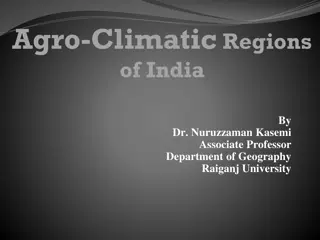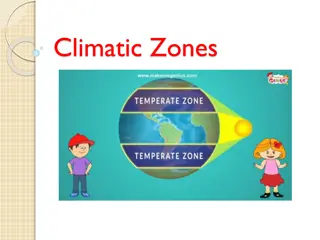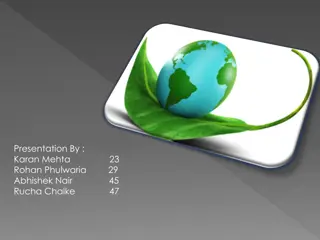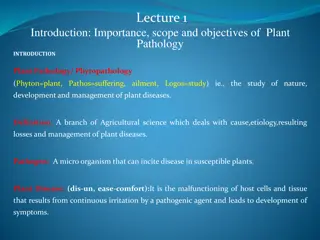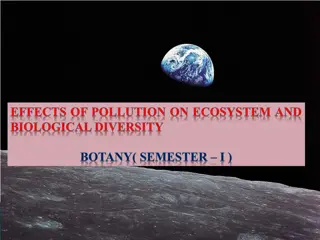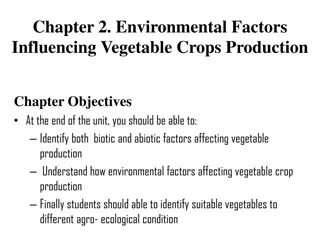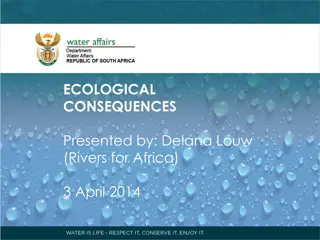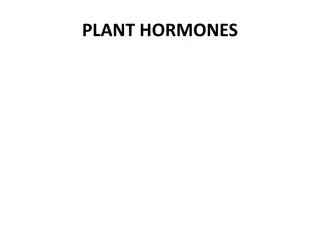Ecological Factors and Climatic Influences on Plant Life
Ecological factors play a crucial role in shaping the environment for organisms to thrive. This includes living (biotic) and non-living (abiotic) components like climatic factors, edaphic factors, topographic factors, and biotic factors. Climatic factors such as light, temperature, water, wind, and fire are essential for plant life, influencing processes like photosynthesis, transpiration, and seed germination. Different organisms have varying tolerances to light intensities and temperature ranges, impacting their metabolic activities and distribution. Understanding these factors is vital for studying plant ecosystems and their sustainability.
Uploaded on Sep 21, 2024 | 12 Views
Download Presentation

Please find below an Image/Link to download the presentation.
The content on the website is provided AS IS for your information and personal use only. It may not be sold, licensed, or shared on other websites without obtaining consent from the author.If you encounter any issues during the download, it is possible that the publisher has removed the file from their server.
You are allowed to download the files provided on this website for personal or commercial use, subject to the condition that they are used lawfully. All files are the property of their respective owners.
The content on the website is provided AS IS for your information and personal use only. It may not be sold, licensed, or shared on other websites without obtaining consent from the author.
E N D
Presentation Transcript
ECOLOGY CLIMATIC FACTOR DR.A.MAAJITHA BEGAM ASSISTANT PROFESSOR OF BOTANY HAJEE KARUTHA ROWTHER HOWDIA COLLEGE UTHAMAPALAYAM
Ecological factors Many organisms, co-exist in an environment. The environment (surrounding) includes physical, chemical and biological components. When a component surrounding an organism affects the life of an organism, it becomes a factor. All such factors factors or ecological factors. These factors can be classified into living (biotic) and non-living (abiotic) which make the environment of an organism. However the ecological factors are meaningfully grouped into four classes, which are as follows: i. Climatic factors ii. Edaphic factors iii. Topographic factors iv. Biotic factors environmental together are called
Climatic Factors Climate is one of the important natural factors controlling the plant life. The climatic factors includes light, temperature, water, wind and fire.
a. Light Light is a well known factor needed for the basic physiological processes of plants, such as photosynthesis, transpiration, seed germination and flowering. The portion of the sunlight which can be resolved by the human eye is called visible light. The visible part of light is made-up of wavelength from about 400 nm (violet) to 700 nm (red). The rate of photosynthesis is maximum at blue (400 500 nm) and red (600 700 nm). The green (500 600 nm) wave length of spectrum is less strongly absorbed by plants.
Based on the tolerance to intensities of light, the plants are divided into two types. They are 1. Heliophytes - Light loving plants. Example: Angiosperms. 2. Sciophytes - Shade loving plants. Example: Bryophytes and Pteridophytes. In deep sea (>500m), the environment is dark and its inhabitants are not aware of the existence of celestial source of energy called Sun. What, then is their source of energy?
b. Temperature Temperature is one of the important factors which affect almost all the metabolic activities of an organism. Every physiological process in an organism requires an optimum temperature at which it shows the maximum metabolic rate. Three limits of temperature can be recognized for any organism. They are 1. Minimum temperature - Physiological activities are lowest. 2. Optimum temperature - Physiological activities are maximum. 3. Maximum temperature - Physiological activities will stop. Based on the temperature prevailing in an area, Raunkiaer classified the world s vegetation into the following four types. They are megatherms, mesotherms, microtherms and hekistotherms. In thermal springs and deep sea hydrothermal vents where average temperature exceed 100oc. Based on the range of thermal tolerance, organisms are divided into two types. 1. Eurythermal: Organisms which can tolerate a wide range of temperature fluctuations. Example: Zostera (A marine Angiosperm) and Artemisia tridentata. 2. Stenothermal: Organisms which can tolerate only small range of temperature variations. Example: Mango and Palm (Terrestrial Angiosperms). Mango plant donot and cannot grow in temperate countries like Canada and Germany.
Thermal Stratification It is usually found in aquatic habitat. The change in the temperature profile with increasing depth in a water body is called thermal stratification. There are three kinds of thermal stratifications. 1. Epilimniotn The upper layer of warmer water. 2. Metalimnion The middle layer with a zone of gradual decrease in temperature. 3. Hypolimnion - The bottom layer of colder water.
Temperature based zonation Variations in latitude and altitude do affect the temperature and the vegetation on the earth surface. The latitudinal and altitudinal zonation of vegetation is illustrated below: Latitude: Latitude is an angle which ranges from 00 at the equator to 900 at the poles. Altitude: How high a place is located above the sea level is called the altitude of the place. Timber line / Tree line : It is an imaginary line in a mountain or higher areas of land that marks the level above which trees do not grow. The altitudinal limit of normal tree growth is about 3000 to 4000m.
Effects of temperature The following physiological processes are influenced by temperature: Temperature affects the enzymatic action of all the bio-chemical reactions in a plant body. It influences CO2 and O2 solubility in the biological systems. Increases respiration and stimulates growth of seedlings. Low temperature with high humidity can spread diseases to plants. The varying temperature with moisture determines the distribution of the vegetation types.
c. Water Water is one of the most important climatic factors. It affects the vital processes of all living organisms. It is believed that even life had originated only in water during the evolution of Earth. Water covers more than 70% of the earth s surface. In nature, water is available to plants in three ways. They are atmospheric moisture, precipitation and soil water. The productivity and distribution of plants depend upon the availability of water. Further the quality of water is also important especially for the aquatic organisms. The total amount of water salinity in different water bodies are :i).5% in inland water (Fresh water) ii).30 35% in sea water and iii). More than 100% in hypersaline water (Lagoons) Based on the range of tolerance of salinity, organisms are divided into two types. 1. Euryhaline: Organisms which can live in water with wide range of salinity. Examples: Marine algae and marina angiosperms 2. Stenohaline: Organisms which can withstand only small range of salinity. Example: Plants of estuaries.
Examples of tolerance to toxicity. i. Soyabean and tomato manage to tolerate presence of cadmium poisoning by isolating cadmium and storing into few group of cells and prevent cadmium affecting other cells . ii. Rice and Eichhornia (water hyacinth ) tolerate cadmium by binding it to their proteins. These plants otherwise can also be used to remove cadmium from contaminated soil ,this is known as Phytoremediation
d. Wind Air in motion is called wind. It is also a vital ecological factor. The atmospheric air contains a number of gases, particles and other constituents. The composition of gases in atmosphere is as follows: Nitrogen -78%, Oxygen -21%, Carbon-di-oxide -0.03%, Argon and other gases - 0.93%. The other components of wind are water vapour, gaseous pollutants, dust, smoke particles, microorganisms, pollen grains, spores, etc. Anemometer is the instrument used to measure the speed of wind. Effects of wind Wind is an important factor for the formation of rain Causes wave formation in lakes and ocean, which promotes aeration of water Strong wind causes soil erosion and reduces soil fertility Increases the rate of transpiration Helps in pollination in anemophilous plants It also helps in dispersal of many fruits, seeds, spores, etc. Strong wind may cause up-rooting of big trees Unidirectional wind stimulates the development of flag forms in trees.
e. Fire Fire is an exothermic factor caused due to the chemical process of combustion, releasing heat and light. It is mostly man-made and some-times develops naturally due to the friction between the tree surfaces. Fire is generally divided into 1. Ground fire Which is flameless and subterranean. 2. Surface fire Which consumes the herbs and shrubs. 3. Crown fire Which burns the forest canopy. Effects of fire Fire has a direct lethal effect on plants Burning scars are the suitable places for the entry of parasitic fungi and insects It brings out the alteration of light, rainfall, nutrient cycle, fertility of soil, pH, soil flora and fauna Some fungi which grow in soil of burnt areas called pyrophilous. Example: Pyronema confluens.
Indicators of fire Pteris ( fern ) and Pyronema (fungus) indicates the burnt up and fire disturbed areas. So they are called indicators of fire. Fire break It is a gap made in the vegetation that acts as a barrier to slow down or stop the progress of fire. A natural fire break may occur when there is a lack of vegetation such as River, lake and canyon found in between vegetation may act as a natural fire break. Rhytidome: It is the structural defense by plants against fire .The outer bark of trees which extends to the last formed periderm is called Rhytidome. It is composed of multiple layers of suberized periderm, cortical and phloem tissues. It protects the stem against fire , water loss, invasion of insects and prevents infections by microorganisms.




